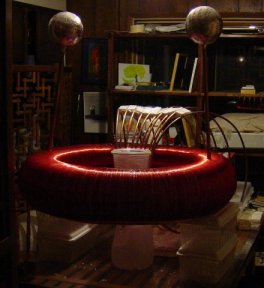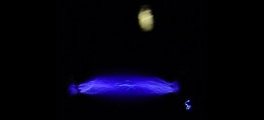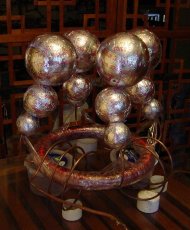 |
 |
 |
 |
|
|
Experimental Tesla Coil Using a Multiple Wavelength
Saskia's Toroidal Secondary
|
| |
| By Jared Dwarshuis and Lawrence Morris |
| August, 2003 |
| Updated January, 2004 |
| |
| |
|
Suppose we make a Tesla coil secondary that is exactly one wavelength long, then suppose we wind it around a toroid instead of a cylinder, and when we are finished winding our coil we connect the ends of the wires and solder them (making one really large closed loop). Theory says that a full wavelength should fit nicely in a coil that is one full wavelength long (seems reasonable). Interestingly we could argue that the very same secondary coil is really two wavelengths long (or three or more) and if we drive the secondary at the right frequency this becomes true. With a two wave length coil we would have 4 voltage nodes and with a three wavelength coil we would get 6 voltage nodes (and these nodes will alternate in polarity as they must).
|
| |
|
Since the speed of light always equals the wavelength times the frequency we can theoretically squeeze in lots of wavelengths but the rub (of course) is that you must use higher and higher frequencies - eventually your tank capacitor stops being effective and your primary inductor becomes a fraction of a turn in length (not very realistic).
|
| |
|
Now Saskia's coil appears to have characteristics that differ somewhat from traditional coils. For example, if we use a single primary and drive a two wave length configuration with four nodes of equal (but intentionally underrated) capacitance, we find that the spark lengths in the rear set are weaker than the front pair (nearest the primary) and that the spark length between front and rear sets are feeble. This trail of energy seems to indicate that a Saskia' coil likes to recycle some of its bypassed energy without need of a hard reflection (much like a standing wave in a circular water tank). The picture at the bottom of the page shows a variation of the above mentioned where we drive two perpendicular nodes, the trail is less pronounced now but still evident.
|

 |
| |
|
Our spark gap always fired smoothly with this coil, suggesting that abrupt changes in energy are smoothed out by the coil itself. This coil also seems to function even when it is badly out of tune. We have found that we could use more than one primary (a primary for each current node) and that we could also wire the primaries opposed and the coil still worked fine (because of symmetry). We are still in the process of determining the full flexibility of Saskia's secondary coil and cannot say if it is either superior or inferior to traditional coils. In theory we should expect to see superb magnetic confinement using a toroidal inductor, but does this translate to bigger sparks? We are not sure yet.
|
| |
|
The picture (top right) is of our recently finished large version coil with 4700 feet of 22 gauge wire over laminated sheets of Styrofoam (which took some 22 hours to wind). |
|
Styrofoam
circles were glued together to get an approximation of a toroid, a razor sharp knife was used to roughly carve the foam to within 1/8 inch of its final dimension, and 36 grit sand paper did the rest. It did not take long to make the coil form, less then 10 hours. When we were finished carving and sanding, we wound the foam very tightly with several layers of 1.5 inch wide mailing tape. The tape smoothes out irregularities and compresses the foam, providing a smooth rigid surface to wind over. After we wound the coil we used a wire brush and polyurethane varnish (varnish acts as a lubricant) to straighten and space out windings for consistent gaps between wires (the wire brush trick works really well). For mounting secondary capacitors, we embedded 8 pieces of 1/2 inch x 1/2 inch x 8 inch PVC pipe hangers with hook sawn off into the coil, and tapped threads into them. These are spaced out for one, two and three wavelength configurations. The primary was wound around a car tire to get the right initial diameter.
|
| |
|
If you decide to experiment with this (presumably) new geometry in coil design we would be upset if you neglected to call it Saskia's secondary (named after Jared's daughter). If someone has already developed this coil topology for resonant transformers (unlikely) we profoundly apologize to the original discoverer.
|
| |
| |

 |
Prototype Construction Notes |
| |
|
Saskia's prototype coil was wound around a 12 inch inside diameter/16 inch outside diameter styrofoam floral wreath (from Frank's Nursery). We used approximately 1440 feet of 28 gauge magnet wire for the secondary (it takes about 5 hours to wind). You will need to stretch the primary out to get the right coupling (which unfortunately, changes the inductance a bit and necessitates recalculation). You can even make a fully enclosed primary as shown to left, but it may be difficult to find exactly the right coupling for it.
|
| |
|
The vacuum gap is powered by a used Kenmore canister vacuum motor. The electrodes are 1/2 inch outside diameter threaded hollow rod (used for assembling free standing lighting fixtures). We cut threads directly into the PVC pipe. (The three primary gaps look to be about 1/8 to 3/16 inch apart.)
Our top end electrodes/capacitors are metal tape over styrofoam balls (also from Frank's Nursery).
|
| |
|
Fabricating the primary for the prototype coil (not shown) was accomplished by wrapping 1/4 inch copper tubing tightly around a 6 inch diameter metal can, then stretching the coil way out to corkscrew it onto the secondary. The primary diameter should be about 2 3/4 times the diameter of the secondary, and for the single primary full wave configuration it should be stretched out to a sector length of about 1 1/4 times the diameter of the secondary. (These are rules of thumb; they should get you fairly close to being properly coupled!)
|
| |
|
One of the authors will be really busy with school soon (plus his wife is getting a bit fizzed about the high voltage mistress). You probably will not hear from us until next summer.
|
| |
| |
| The Math We Used |
| |
|
The frequency is dictated by wire length, you must make sure that you keep this frequency after you have adjusted your primary and top end capacitance.
|
| |
|
Speed of light / d = 1/ 2 π √ (L1C1) = 1/ 2 π √ (L2C2)
|
|
where d = wire length of entire secondary for a full wave, d/2 for a two wave, d/3 for a three wave etc.
C1 = tank capacitor L1= primary inductor (solve L1 for a given C1)
|
| |
|
L2 is based on 1/4th the total number of turns in the entire coil for the full wave configuration and 1/8th the total number for a two wave configuration and 1/12th for a three wave.
|
| |
|
For inductance we used L = ((4 π times 10 to the minus 7) X (cross section area of coil) X (number turns squared)) / length Where length is the sector distance. Sector distance is calculated using the average of the inside and outside radius of the toroid (this finds the centerline distance for the flux) so for a full wave it would be ((r1 + r2) / 2) x (2 π / 4). (Use metric units [meters] for this calculation.)
|
| |
|
C2 is calculated only as a maximum value. Roughly about 1/2 of Medhurst's coil capacitance must be subtracted from C2 and the value of C2 is split between the voltage nodes (treat section as solenoid for this approximation, use inside radius for solenoid height).
|
| |
|
Mathematically the upshot is that you have a fixed length for the entire coil and for a full wave we mathematically consider only one quadrant of the coil and then apply standard quarter wave Tesla math to it. (And yes you are correct that with only one primary, half the coil basically goes along for the ride).
|
| |
|
Now if we want to put in two waves consider only 1/2 the coil and apply the same quarter wave math.
|
| |
| |
| Summary |
| |
|
You may wonder did these guys just get lucky? Well, no, not really. We just know that you can get anything to resonate, it's all a matter of timing and geometry. Energy loves to be conserved so it should not be a big surprise that we can simply ignore most of the coil when doing our calculations. Also grand things happen when you appeal to symmetry (waves arrive on time). We gave a lot of thought to what we were doing (most of which was within the limits of thought adhesion) and followed the edict "if it is not strictly forbidden it's permitted." We have modest resources and limited time so we have no quantitative data as of yet. There is a bit of tune by ear involved but Saskia's secondary works very well.
|
| |
| |
|
Good Luck and Don't Get Hurt!
|
















